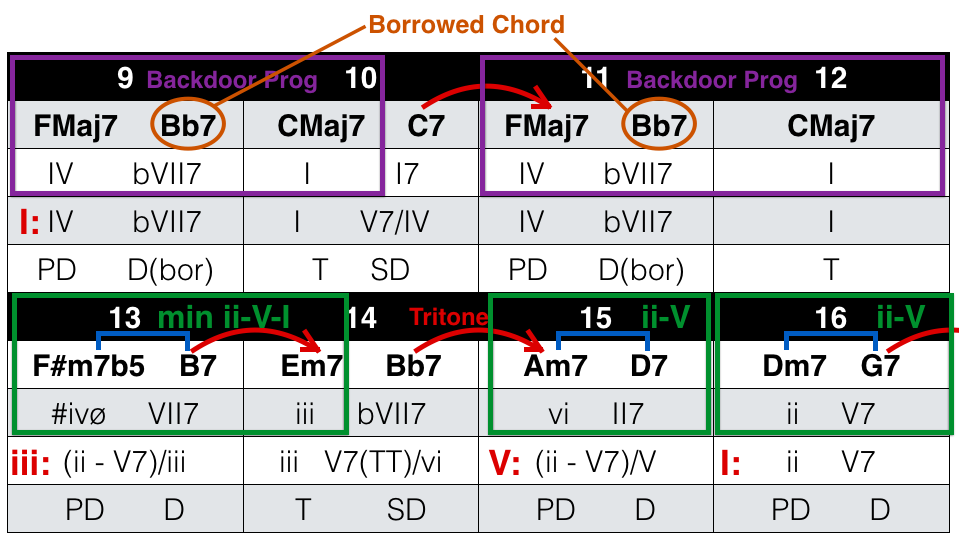Subjectivity and Practice
In this lesson I plan to show you how to analyse a chord progression and discuss how you can use this information to improvise. And we are going to use the first half of the Jazz Standard My Romance as our example.
Analysing a chord progression is partially subjective. There are a number of different ways to analyse the same chord progression – so the way I’m going to do it is not the only way you can do it. I’ve got my own personal preferences and biases which I will explain as we go. And unfortunately, learning how to analyse a progression well only comes with practice. There are certain patterns and clichés that you discover only by analysing lots of different Jazz Standards.
How to Analyse a Chord Progression
When analysing a chord progression, take the following general steps:
- Analyse the overall Form of the song;
- Analyse the First Level Chord Progression – this looks at each individual chord as a separate, standalone entity;
- Analyse the Second Level Chord Progression – this looks at only the structurally important chords and functionality, ignoring immaterial passing chords. But what is ‘important’ and what is ‘unimportant’ is to an extent subjective.
My Romance
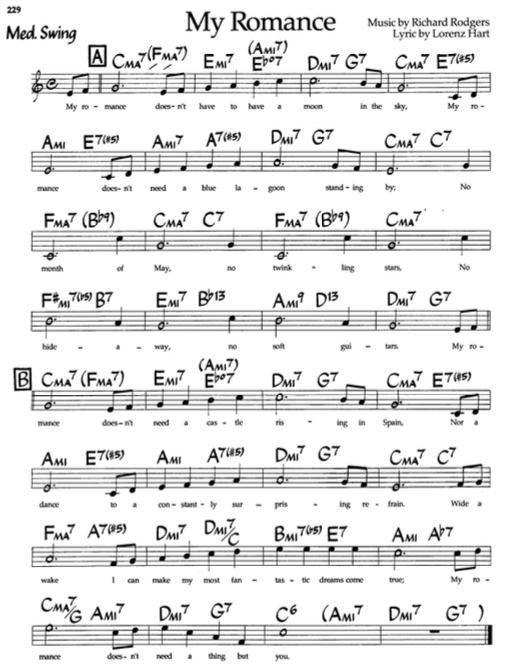
Form
So first, we look at the overall form of the song (note that the form shown in the above lead sheet is incorrect). For this you look at the:
- Number of bars
- And the sections
In Jazz some common song forms used are the:
- 12 Bar Blues
- 32 Bar AABA
- 32 Bar ABAC
- 16 Bar AB
So looking at My Romance, we see it has a 32 bar ABAC form. Easy. Moving on.
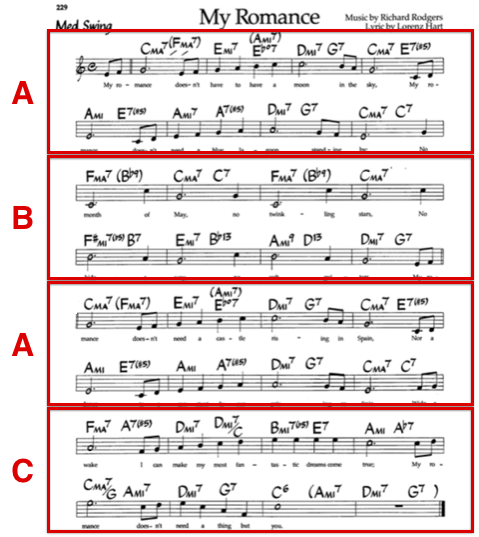
First Level Chord Progression
Next, we look at the First Level Chord Progression. To do this we:
- Determine the key
- Find the Key Signature
- Find Cadences at end of phrases and sections
- Look for ii-V-I’s, V-I’s, and ii-V’s (incomplete cadences that resolve to the I chord at the beginning of the next section)
- Or if it’s a blues, you’ll find IV-I plagal cadences at the end of phrases
- The last chord of the song is often the tonic
- Label all chords with Roman Numerals based on their relationship to the I chord
If we look at My Romance we see that the key signature is in C Major. We also see that section A ends with a ii-V-I in C with the C7 being a kind of pickup or anacrusis chord (in fact a secondary dominant) leading to the next section. And section B ends with an incomplete ii-V in C. So I think it’s pretty clear that this song is written in the key of C Major. Notice also that the last chord of the song (ignoring the turnaround) is C6.
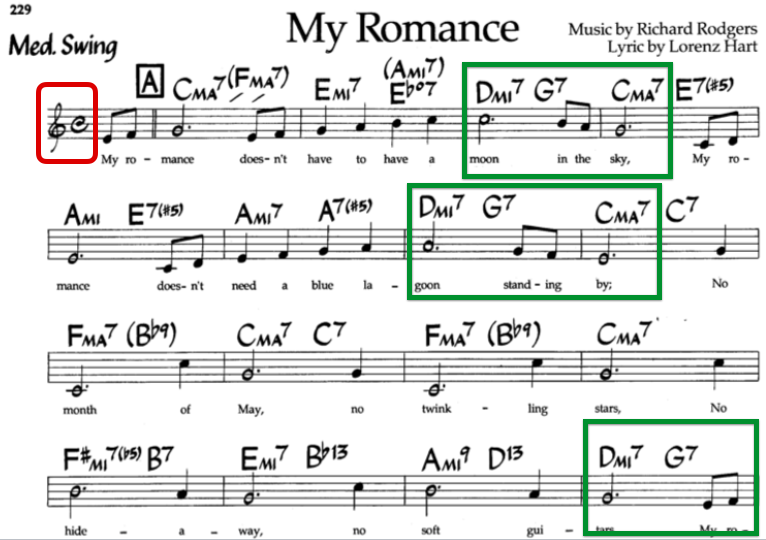
Next, we label all chords with Roman Numerals based on their relationship to the I chord (see below). I find it helps to write out all the diatonic chords of the key, just for your own reference.
CMaj7, Dm7, Em7, FMaj7, G7, Am7, Bm7♭5
Now, this First Level analysis doesn’t tell you very much, but it’s a start.
Second Level Chord Progression
Next, we look at the Second Level Chord Progression. On this level we are looking to reduce the First Level Progression to its simplest form by getting rid of the unimportant chords and keeping only the structurally important chords. In this way we analyse the progression in terms of its functionality. Essentially, we want to reduce each chord into one of three categories:
- Predominant (P) – pulls or wants to resolve to the Dominant
- Dominant (D) – pulls or wants to resolve to the Tonic
- Tonic (T) – sounds at rest and resolved
| Function | Tension | Chord |
|---|---|---|
| Tonic | None | CMaj7, Em7, Am7 |
| Dominant | Lots | G7, Bø7 |
| Pre-Dominant | Some | Dm7, FMaj7 |
Functional Chord Progressions generally move through the following pattern:
Tonic→Pre-Dominant→Dominant→Tonic
And in Jazz the PD→D→T Progression generally takes the form of a ii-V-I.
ii-V-I’s are the building blocks of Tonal Jazz. They are everywhere, so look for them in every song.
Once you find this PD→D→T cadential progression, everything before the Pre-Dominant Chord is considered ‘Tonic Prolongation‘ – that is, chords that prolong the Tonic without a cadence.
A phrase can have a complete cadence – so ending on the Tonic:
T—————— PD D T
Or an incomplete cadence – so ending on the Dominant:
T—————— PD D
For example:

So Tonic Prolongation is literally that; chords that just serve to prolong the Tonic function. These are generally substitutions of the tonic chord or just quick passing chords. Even the V7 chord above doesn’t really sound like a cadence as it is very quick and hasn’t been prepared by a Pre-Dominant chord.
Second Level Analysis Steps
When analysing a chord progression on the Second Level I perform the following steps:
- Complete the First Level Analysis
- Look and label all ii-V-I’s
- Look for Tonic Prolongation
- Look and label non-diatonic chords
Non-diatonic chords can either:
- Change the tonal centre for a long period of time, in which case we call this modulation; or
- Change the tonal centre for a short period of time or not at all, in which case it can be either a:
The thing passing chords, borrowed chords and secondary dominants all share in common is that they are generally very quick and last for no more than 1/2 to 1 bar, and as such do not have time to change the tonal centre, or only change the tonal centre for a short period of time.
My personal bias: modulation is a last resort. I try to analyse chords as passing, borrowed, substitute or secondary dominant first, if possible. And only then do I consider modulation. This is just a personal bias, and you can argue otherwise.
So looking at Section A of My Romance.
- I label all the ii-V movements with brackets and all the V-I movements with arrows; this allows me to find all the ii-V-I movements
- Then everything before this ii-V-I movement is a Tonic Prolongation
- I look for and label passing chords, borrowed chords, substitutions, and secondary dominants.
Below is a table with the chord progression for My Romance written out and analysed.
The first row is the bar numbers.
The second row is the chord progression.
The third row is the First Level Chord Progression.
The fourth row is the Second Level Chord Progression.
The fifth row is the Function of each chord.
Roman Numerals in red are the modulations/key changes
Section A
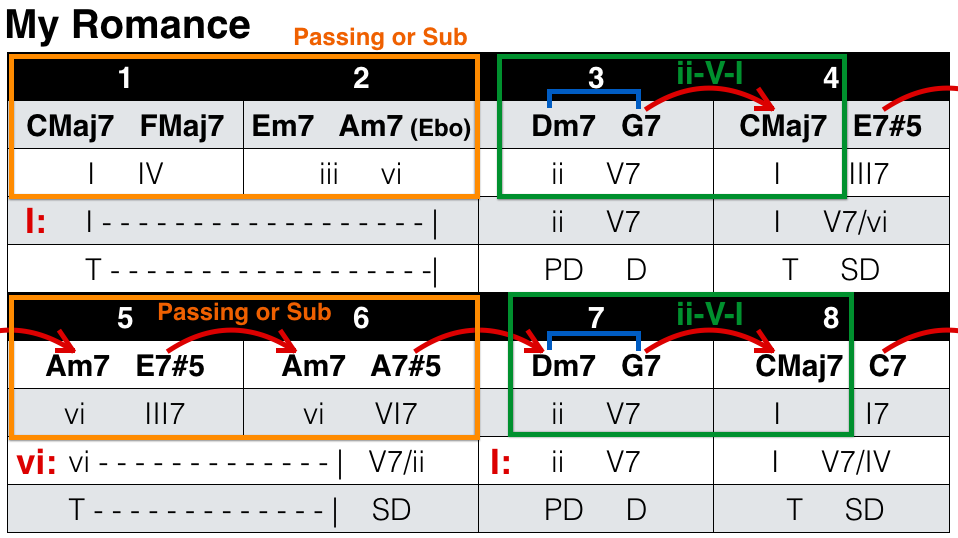
- Bars 1 & 2 are just a Tonic Prolongation of the CMaj7 chord.
- FMaj7 is a quick passing chord.
- Em7 and Am7 are both chord substitutes of CMaj7.
- E♭o (which is an alternate chord given in the lead sheet) is just a passing chord.
- In bars 3 & 4 we have a ii-V-I in C, which we label PD, D and T.
- So bars 1 – 4 are all in the key of C Major.
- At the end of bar 4 we have a secondary dominant, which I have labelled SD. This E7#5 chord tonicises the Am7 chord, which is of course, the relative minor of C Major. Then another E7#5 chord takes us to another Am7 chord. Here we are playing a V-I-V-I chord progression in the key of A minor. I would call this a modulation, because it lasts for 2 bars, which is a relatively long time, and because it’s moved to the relative minor which is a really common modulation.
- And there are no ii-V-I’s in the key of A minor, so there is no PD→D→T progression. Instead the chord progression moves quite quickly through a V-I-V-I progression, so I would call this a Tonic Prolongation of the Am7 chord.
- Then at the end of bar 6, we have another secondary dominant which is tonicising the Dm7.
- In bar 7 and 8 we have a ii-V-I in C.
So then to summarise, Section A starts in C Major, plays a Tonic Prolongation followed by a ii-V-I. This then modulates to the key of A minor for two bars, and returns to the key of C Major for the final two bars with another ii-V-I. This is followed by a secondary dominant, tonicising the FMaj7, which is the first chord is Section B, to which we now turn our attention.
Section B
- In bars 9 & 10 we have an FMaj7 (which is the IV chord of C Major and has a PD function) moving to the B♭7 chord (which is a♭VII7 and a D function). And this is where practice and experience comes in handy. This may look like a bit of a strange progression, but really it’s a simple backdoor progression. And the B♭7 is a borrowed chord from the parallel minor (C Aeolian). And this B♭7 functions as a plain old Dominant chord. So it’s still a PD→D→T progression in the key of C, we’ve just used modal interchange to make it a bit more interesting.
- This is then followed by a secondary dominant tonicising the FMaj7 chord and we go straight into another backdoor progression.
- So bars 9 – 12 are all in the key of C Major, even though the contain some non-diatonic chords.
- In bars 13 & 14 we have a minor ii-V-I in E minor, so we have modulated to the key of E minor. We then have a B♭7 moving to an Am7. Now, the B♭7 is a tritone substitution of an E7, which is the V7 chord of Am7. So really this is a tritone substitution of a secondary dominant chord.
- Then in bar 15 we have a ii-V in G Major, which is the relative major of E minor.
- And we finish with a ii-V back in our original key of C Major.
- You could also argue that bars 15 – 16 are both in the key of C Major and the D7 is just a passing chord between Am7 and Dm7.
And that very long explanation is how to analyse a chord progression.
First and Second Level Improvisation
Ok, so we have now analysed the above chord progression. Great. Now what? What do we do with this information? Well, we can use it to influence how we improvise over this song.
In the same way that we distinguished between the First Level chord progression and the Second Level chord progression, we can make a similar distinction with improvisation. We can have a First Level improvisation or a Second Level improvisation.
A First Level improvisation (the first row under the Roman Numerals – 4th row down) simply involves soloing using the relevant mode for each chord. This is a perfectly fine way to solo, but it has one obvious drawback. Because the chords change every half bar on average, you have to change scales every half bar. This can be a little bit challenging.
So instead we can play a Second Level improvisation. That is, play the scales that relate only to the Second Level, functional, important chords (the 5th row down). Further, if there is a non-diatonic chord played for a short period of time (like in bar 6 with the A7#5; or in bars 8 & 10 with the C7; or bar 14 with the B♭7) I would just play straight through or straight over the harmony, ignoring the chord change. Because these chords only last for a short period of time (only half a bar), you’re only playing the ‘wrong’ scale very quickly (which builds up tension) before resolving that tension with the next chord (so keep playing A minor over the A7#5; C Major over the C7’s; and E minor over the B♭7).
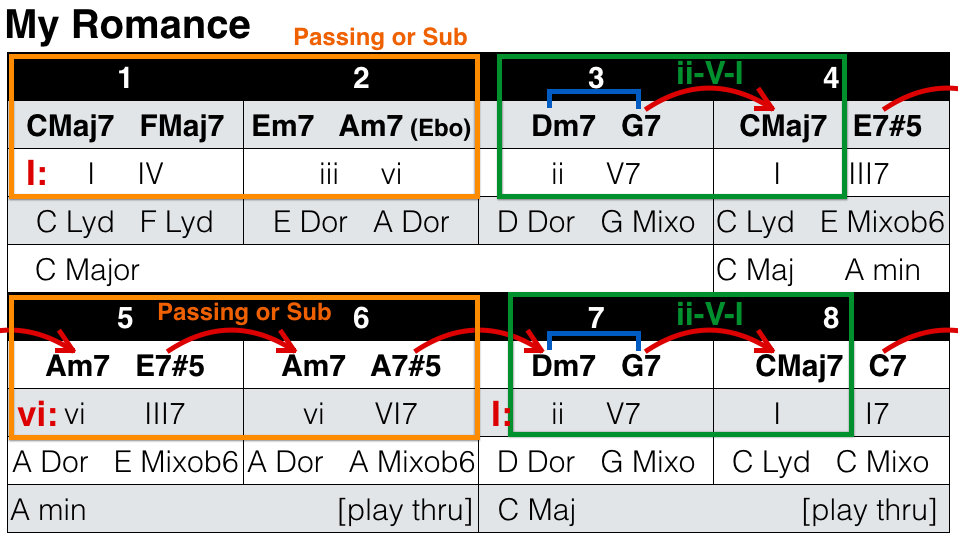
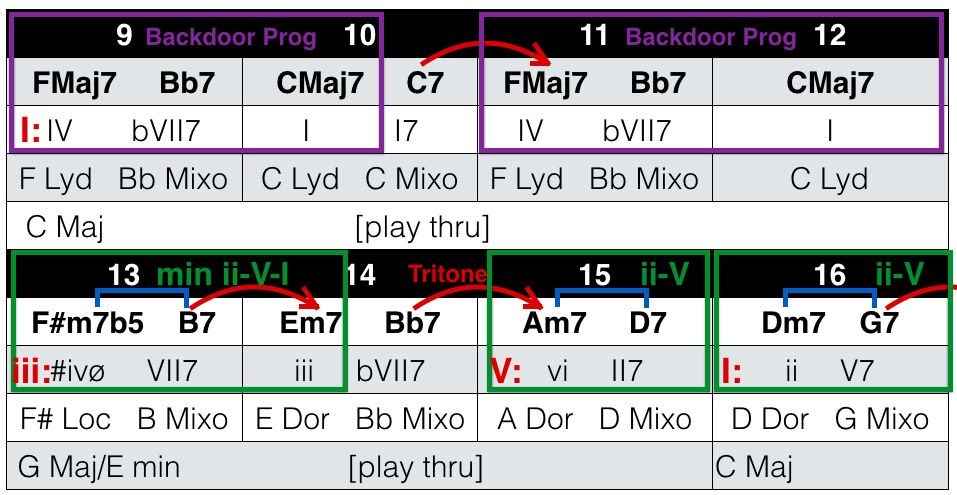
So the Second Level improvisation is much easier than the First Level because we are using far fewer scales. And of course, you would use these scales as a ‘base scale’ from which to depart into more exciting improvisational ideas and techniques – like side slipping, cycled patterns, chromatic runs, etc.
So even though we have a relatively complex chord progression, by thinking about it on the Second Level we can break it down to a few really simple keys and scales and then add the usual chromaticism and complexity that Jazz typically exhibits.
Conclusion
So as you can see, analysing a chord progression can actually be quite challenging and rather subjective. Again, it’s worth repeating that there is more than one way to analyse a chord progression, and my way isn’t necessarily 100% definitive. And also note that chord progressions can be far more complex than this. You can also have Pre-Dominant Prolongation and Dominant Prolongation chords, but Tonic Prolongation is the most common.
It’s also worth mentioning that this Second Level harmonic analysis only works with functional chord progressions. In more modern Jazz, we often find non-functional chord progressions. That is, the chords do not pull towards a tonic chord or tonal centre, so we have chord progressions that seemingly float around without any reference point or resolving chord. Now, you can’t really analyse a non-functional chord progressions using this functional Second Level harmonic analysis. Instead, we would just stop at the First Level and look for common scales.
